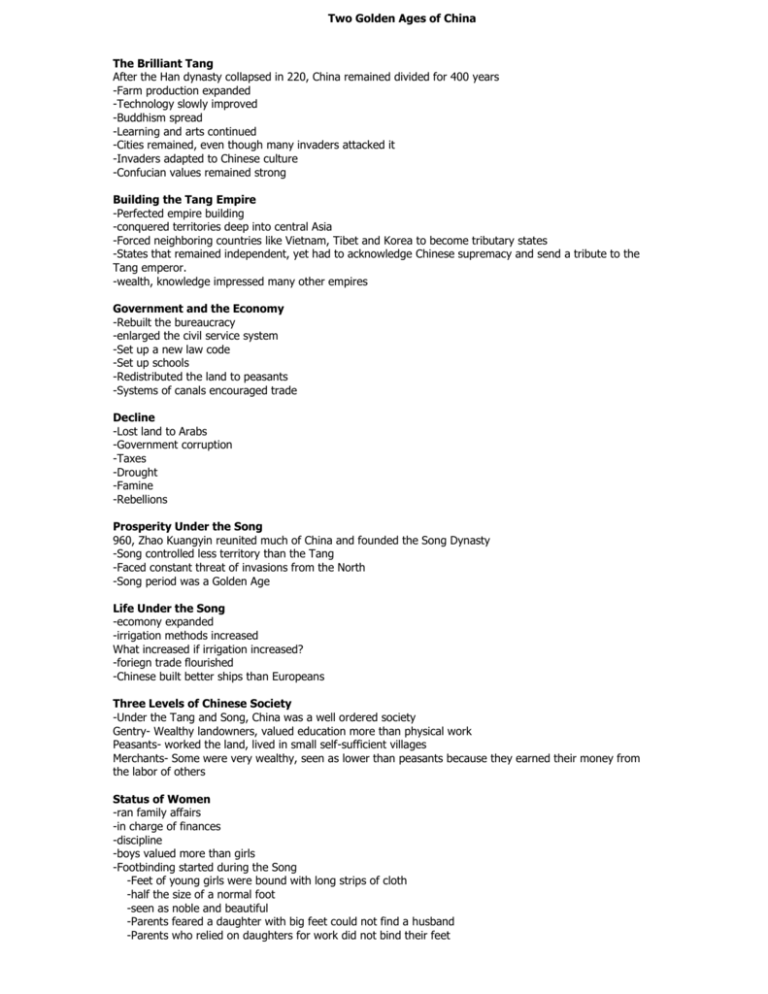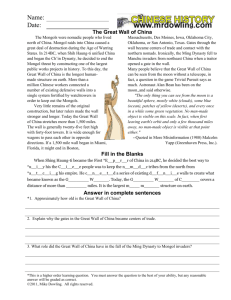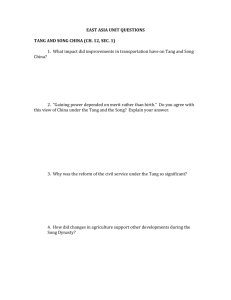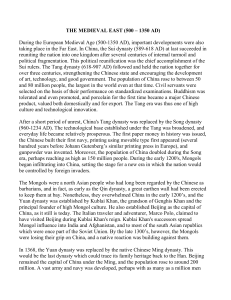Chapter 13 section 1 - Valley Central School District
advertisement

Two Golden Ages of China The Brilliant Tang After the Han dynasty collapsed in 220, China remained divided for 400 years -Farm production expanded -Technology slowly improved -Buddhism spread -Learning and arts continued -Cities remained, even though many invaders attacked it -Invaders adapted to Chinese culture -Confucian values remained strong Building the Tang Empire -Perfected empire building -conquered territories deep into central Asia -Forced neighboring countries like Vietnam, Tibet and Korea to become tributary states -States that remained independent, yet had to acknowledge Chinese supremacy and send a tribute to the Tang emperor. -wealth, knowledge impressed many other empires Government and the Economy -Rebuilt the bureaucracy -enlarged the civil service system -Set up a new law code -Set up schools -Redistributed the land to peasants -Systems of canals encouraged trade Decline -Lost land to Arabs -Government corruption -Taxes -Drought -Famine -Rebellions Prosperity Under the Song 960, Zhao Kuangyin reunited much of China and founded the Song Dynasty -Song controlled less territory than the Tang -Faced constant threat of invasions from the North -Song period was a Golden Age Life Under the Song -ecomony expanded -irrigation methods increased What increased if irrigation increased? -foriegn trade flourished -Chinese built better ships than Europeans Three Levels of Chinese Society -Under the Tang and Song, China was a well ordered society Gentry- Wealthy landowners, valued education more than physical work Peasants- worked the land, lived in small self-sufficient villages Merchants- Some were very wealthy, seen as lower than peasants because they earned their money from the labor of others Status of Women -ran family affairs -in charge of finances -discipline -boys valued more than girls -Footbinding started during the Song -Feet of young girls were bound with long strips of cloth -half the size of a normal foot -seen as noble and beautiful -Parents feared a daughter with big feet could not find a husband -Parents who relied on daughters for work did not bind their feet Chapter13 section 2 The Mongol and Ming Empires The Mighty Mongol War Machine Genghiz Khan was born in 1162 -from birth he was marked from greatness -Mongols started out as nomadic people who searched for land for their sheep to graze -Suffered major disasters in battle after his father was poisoned (too young) -Age 15 he was taken prisoner, escaped to the mountains -Outcast among many different clans, developed a reputation of courage -At age 45 he was elected supreme ruler of the Mongols Mongols in Battle Genghiz Khan imposed strict military discipline -demanded absolute loyalty -tough, skilled soldiers -travel for days at a time -eating a few handfuls of grain -drinking mare's milk -Most skilled horsemen in the world Mongol Women -Skilled warriors and fighters -Some commanded their own military forces -Most took care of managing the needs of the camp Advance to China Faced the problem of walled cities -Used cannons and other modern weapons to attack Effects of Mongol Domination -The Heirs to Khan expanded the Mongol Empire -Dominated Asia for the next 150 years -took over Muslim lands, to China -Were not oppressive rulers -Allowed people to live as they did before (paid a tribute) -Mongols controlled the Silk Road The Yuan: A Foreign Dynasty -Genghis Khan conquered Northern China -Took 70 years to conquer the South -Genghis's grandson Kublai Khan took over the last Song emperor in 1279 Government -Kublai tried to keep the Mongols from being absorbed into Chinese civilization -Only Mongols could serve in the military -Highest government jobs went to Mongols -Uneasy mix of of Chinese and foreign ways developed Kublai adopted a Chinese name for his empire (Yuan) Western Visitor Italian merchant named Marco Polo -Spent 17 years in Kublai's service -Amazed at the wealth and splendor of Asia -Astonished readers in Europe -Contact with Europe and Asia increased -Mongols were tolerate of other people The Ming: Restoring Chinese Rule -Yuan dynasty declined after the death of Kublai Khan -Most Chinese despised the Mongol rulers -Confucian scholars retreated into their own world -Heavy taxes, corruption, and natural disasters led to frequent uprisings -Zhu Yuanzhang forged a rebel army that took over the Mongols, and pushed them back beyond the Great wall -1368, he founded the Ming dynasty which meant brilliant -early Ming rulers wanted to assert Chinese greatness after years of foreign rule -Ming restored the civil service system Economic Revival -economically, Ming China was very productive -Fertile well irrigated plains of Eastern China supported a population of more than 100 million -1500's, new crops reached China from the Americas (corn and sweet potatoes) -Chinese cities were home to many industries including porcelain, paper and tools -Repaired the broken canal system -Better ways of printing increased the number of books China and the world -Early Ming rulers sent many Chinese fleets to distant waters The Voyages of the Zheng He -1405, Zheng He headed a fleet of 62 huge ships (longest one was 400 ft long) -Goal of the voyage was to promote trade and collect tributes from other countries -Made voyages around India, and Southeast Asia, even to Africa -Brought back exotic animals like giraffes from Africa -Showed the supremacy of the Chinese Empire to other countries Turning Inward 1433, Zheng died, the Ming emperor banned the building of seagoing ships -stopped the ships because they were expensive and didn't return any profit -Confucian scholars did not have interest in oversea areas -At this point, Chinese civilization was the most successful in the world Chapter 13 section 3 Korea and its Traditions Geography: The Korean Peninsula -Korea is a peninsula -Steep mountains cover nearly 70 percent of the Korean peninsula -Most important mountain range called the T'aebaek runs North and South along the Eastern coast -Korea's farming region is located in the Western coastal plains -Hundreds of good harbors -Thousands of islands -depended on seafood for protein in their diets Impact of Korea's Location -On China's doorstep -Received many cultural and technological influences from China -At times, China imposed political control over Korea -Served as a cultural bridge between China and Japan -Koreans have adapted and changed Chinese traditions before passing them to the Japanese -Korean language is unrelated to Chinese language Korea United Between 300 and 600 A.D. powerful rulers forged three kingdoms 1. Koguryo- located in the North 2. Paekche- Located in the southwest 3. Shilla- Located in the Southeast Shared the same language and background, but often fought 668 with help from the Tang, the Shilla united Korea Korea only had three dynasties: 1. Shilla 2. Koryo 3. Choson Under the Shilla dynasty, Korea became a tributary state -Koreans adopted Confucian traditions -Women's public roles became restricted Koryo Dynasty -Buddhism reached its peak during this dynasty -Produced many Buddhist texts -Korean inventors came up with moveable type Choson: The Longest Dynasty 1392, Yi Song-Gye founded the dynasty -reduced Buddhist influences -Set up a government based on Confucian principles -Replaced the Chinese system of writing with Hangul -an alphabet using symbols to represent sounds in Korean -Easier for the Koreans to use, less symbols Chapter 13 section 4 An Island Emerges Geography: Japan, a Land Apart -Located on a archipelago (chain of islands) -Consists of four main islands (Hokkaido, Honshu, Kyushu, and Shikoku) -About the size of Montana -4/5 of the land is too mountainous to farm -As a result, people settled in river valleys along the coastal plains -Natural barriers were obstacles for trying to unite Japan -China was too far away for Japan to conquer -Developed a thriving fish market Ring of Fire -Philippines, Indonesia, parts of Australia and South America, and Japan all lay within this ring of Fire -Area is subject to frequent earthquakes, volcanoes and Tsunamis Early Traditions Yamato Clan -Each clan had it's own chief and a special god or goddess -Some clan leaders were women -500 A.D. Yamato clan dominated the corner of Honshu -Set up Japan's first and only dynasty Shinto -Kami (clan gods and goddesses)were generally nature spirits -Worshipping the forces of nature became known as Shinto (meaning way of the gods) -Evolved into a religion The Korean Bridge -Japanese language is distantly related to Korea's, but completely different than Chinese -500 A.D. missionaries from Korea introduced Buddhism to Japan -Sparked a sudden urge for Chinese knowledge Japan Looks to China 600's, Prince Shotoku (Yamato ruling family) decided to learn about China directly -sent young Japanese scholars to China to study Imported from the Tang Scholars returned to Japan -eager to spread what they learned in China (thought, technology, and the arts) -imported ideas about Chinese government -Set up a bureaucracy -believed in a holy emperor who claimed absolute power -Old clans still remained strong in the countryside -As Buddhism spread, Japanese adopted pagoda architecture Selective Borrowing -Kept some Chinese ways, or modified and discarded others -Never accepted the Chinese civil service system -Japanese separated themselves by using Kana (phonetic symbols representing syllables) The Heian Period (794-1185 ) Noblemen and Women lived a fairy-tail life (pavilions, gardens, etc..) -dressed in silk -Men could learn Chinese, women could not Women Writers (Heian Period) -A women by the name of Sei Shonagon wrote a book called The Pillow Book -gives vivid details about court life (dress, manners, etc..) -Lady Murasaki was Shonagon's rival -wrote The Tale of Genji considered the world's first novel -about the life Prince Genji and his son Chapter 13 Section 5 Japan's Feudal Age Age of the Samurai Emperor presided over the court in Heian -Local warlords and even Buddhist temples formed bands loyal to themselves, and not their government -As these groups fought, Japan evolved into a feudal system Feudal Society In theory, the Emperor headed society -In fact, he was powerless (figurehead) -Real power lay with the shogun (supreme military commander) -Often, the shogun only controlled a small part of Japan -He distributed land to vassal lords who agreed to support them if needed -These great warrior lords were later called daimyo -granted land to lesser warriors called samurai (meaning those who serve) Bushido Samurai were heavily armed, and well trained -developed a code of values called Bushido (way of the warrior) -emphasized honor, bravery, and loyalty to one's lord The true samurai had no fear of death -samurai who betrayed the code of bushido would be expected to commit seppuku (ritual suicide) Women -status declined during samurai age -inheritance was only given to sons -bushido did not respect women Mongol Invasions -During the feudal age, most fighting took place between warlords -Mongol conquest of China, and Korea also threatened Japan -Japanese refused to accept Mongol rule, Kublai Khan launched an attack from Korea in 1274 -Khan attacked with ships, typhoon wrecked many of his ships twice -Japanese attributed this fortune to the kamikaze, divine winds Order and Unity Under the Tokugawas Kamakura Shogunate crumbled after the Mongol invasions -Several powerful warriors united large parts of Japan -Tokugawa defeated all rivals for power -Founded the Tokugawa shogunate (1603-1868) Centralized Feudalism -Tokugawa shoguns wanted to end feudal warfare -Imposed central government control (centralized feudalism) -Created a unified, orderly society -Strict moral code Economic Growth -With peace restored in the countryside, agriculture picked up -new seeds, tools and fertilizer increased production -Trade flourished Zen Buddhism -emphasized meditation and devotion to duty -Zen monks were great scholars -valued an uncluttered mind -Compassion for all, yet samurai fought to kill Zen Buddhism shaping life Zen monasteries, men learned how to express devotion to nature (landscaping) -Believed people could seek enlightenment, not only through meditation, but through everyday tasks Two Golden Ages of China The Tang Empire -Invaders adapted to Chinese culture -Forced neighboring countries to become tributary states *States that were independent, but had to acknowledge Chinese supremacy and pay tribute to the Tang emperor. Government and the Economy -civil service system -new law codes and schools -Redistributed land to peasants -canals encouraged trade Decline -Lost land to Arabs -Taxes -Drought The Song Empire Zhao Kuangyin reunited much of China and founded the Song Dynasty -Faced constant threat of invasions from the North -Song period was a Golden Age -economy expanded -irrigation methods increased -foreign trade flourished -Chinese built better ships than Europeans Under the Tang and Song Gentry- Wealthy landowners, valued education more than physical work Peasants- worked the land, lived in small self-sufficient villages Status of Women -in charge of finances -ran family affairs -Foot binding started during the Song









